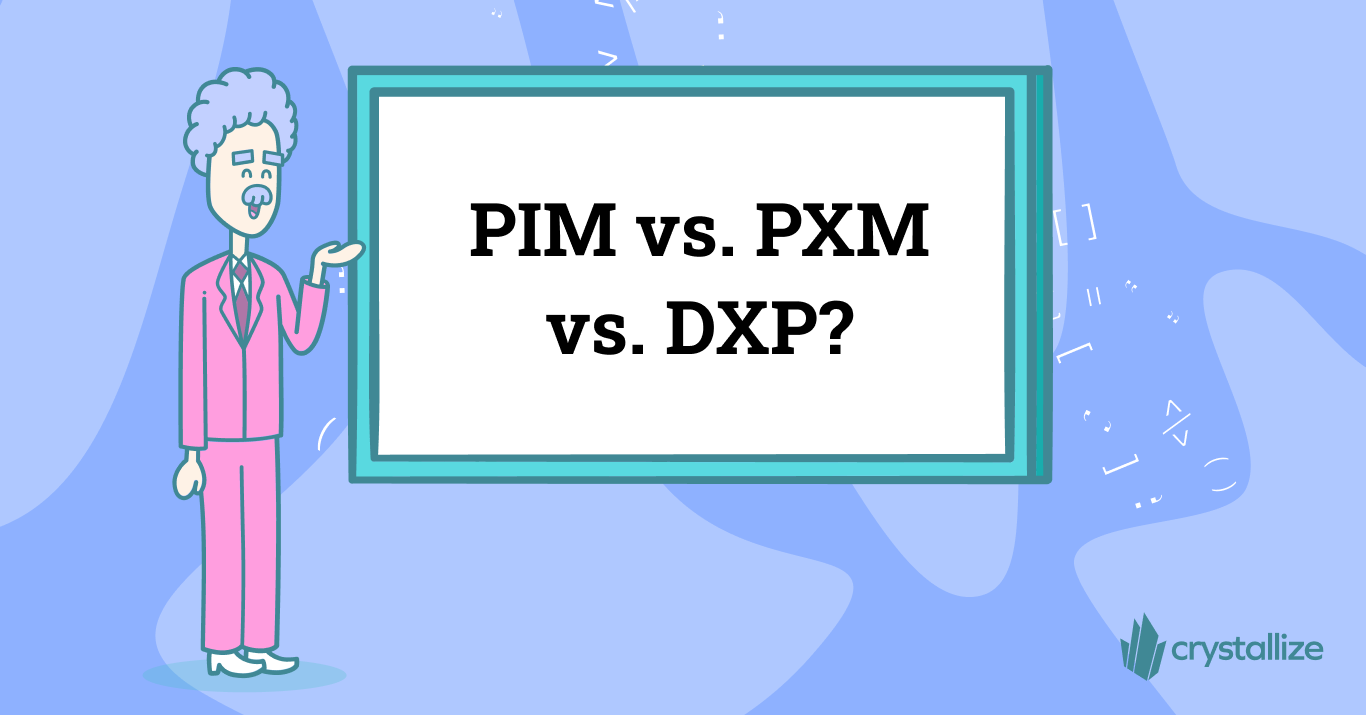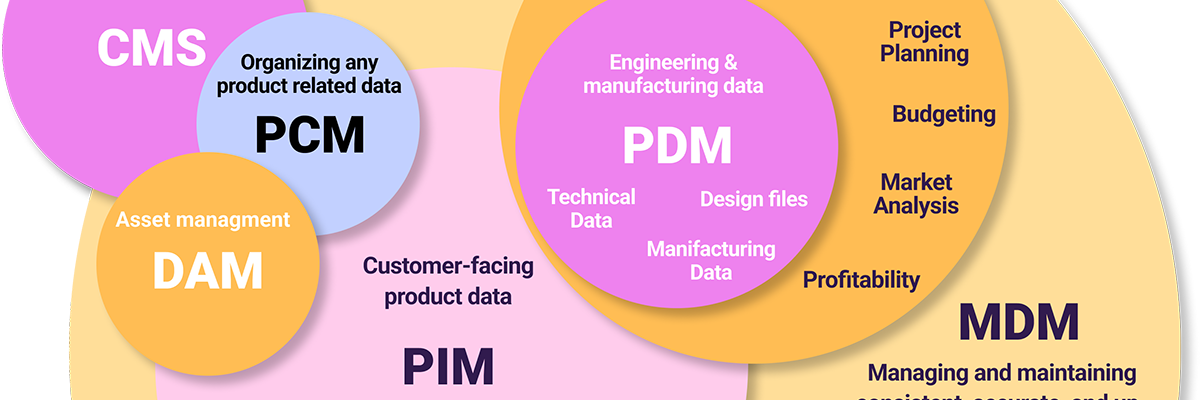PIM vs. PXM vs. DXP: Understanding the Concepts
Personalized experiences increase the likelihood of purchase by 80% for consumers. And with that, experience management platforms (XM) entered the scene.

80% for consumers. Let that sink in. We’ve been advocates of personalized shopping experiences since the beginning of Crystallize.
Product Information Management (PIM), Product Experience Management (PXM), and Digital Experience Platform (DXP) are all related concepts that help organizations manage and optimize product-related data.
In short, PIM focuses on centralizing and standardizing product information, PXM focuses on creating engaging and personalized experiences for customers, and DXP focuses on creating and managing digital experiences across all channels.
But it’s not all that simple. Let me explain.
What is Product Experience Management (PXM)?
Product Experience Management (PXM) uses product-related data in order to provide personalized product experiences designed to engage customers.
In that, it helps companies to increase sales and overall customer satisfaction through customization of the experience, recommendation systems, etc.
Best PXM software for 2023
- Salsify PXM: Salsify is a highly efficient SaaS platform that provides users complete authority over their products through capabilities such as product information management and digital asset management, making it effortless for them to manage and regulate their products. Salsify PXM is especially great for e-commerce businesses because it uses machine learning to study millions of products in its shared database.
- Akeneo: Akeneo's PXM helps gather, standardize, enrich, and distribute product information tailored to each channel and location, creating a consistent and personalized experience for customers. It works with a network of technology partners, including eCommerce, print, marketplace, mobile, POS, and DAM platforms. It’s one of the best enterprise open-source platforms.
- Qualtrics: Qualtrics PXM is a Gartner leader in customer experience, unifying all your experience management needs in one platform: design XM, customer XM, employee XM, product XM, brand XM, and more.
💡Can Crystallize be used as PXM and/or DXP?
Yes. Crystallize is designed for product storytelling. With advanced content modeling at the core, you can design your product universe. This involves designing product structures, hierarchies, relationships, taxonomies, etc. Allowing you to describe both the core product information semantically and also the supporting information and content required to tell the whole story.
Let us dive into the Crystallize “Hello world” example for storytelling, which is about selling food. To create an experience around tomatoes and basil, you create a product universe of recipes on how you can create delicious Pizza with these ingredients. Products are enriched with details like nutritional information, vegetarian or vegan, and cooking time.
With Crystallize being headless, you can fetch the information in real time and use it for any channel, including POS, App, Web, or even for product merchandising in PDF catalogs. In other words, natively multi-channel.
Since you can describe your products in a rich manner, you can easily use this to provide personal experiences. The real-time GraphQL API in Crystallize allows you to extract exactly the information required to create a personalized experience. For example, showing inspiring recipes that are vegan and can be cooked in less than 30 minutes. Or ingredients you frequently have purchased before.
We even have partners that have referred to Crystallize as a “headless DXP.” For us, these are all acronyms. We describe Crystallize as the headless service to market and sell your products in any channel, at any scale, in any way you dream it.
PIM Vs. PXM: What are the differences?
PIM and PXM are related concepts that deal with product-related data but have different focuses.
As we explained in what is PIM post, PIM focuses on centralizing and standardizing product information. PXM, on the other hand, focuses on creating engaging and personalized customer experiences by using product-related data.
PIM is more about managing and organizing product information, whereas PXM is more about creating a personalized and engaging experience for the customer.
What is a Digital Experience Platform (DXP)?
A Digital Experience Platform (DXP) is a software platform that allows companies to create, manage, and optimize digital experiences across multiple channels and touchpoints.
It provides a central place for creating, managing, and delivering content, personalization, and analytics, allowing for a consistent and personalized experience for customers.
Where Does DXP Fit?
DXP and PXM are related concepts, but they have different focuses.
While PXM is mainly focused on product-related data, DXP is more focused on creating a consistent and personalized experience for customers across all digital touchpoints, such as websites, mobile, social media, email, and so on. It can also be used to manage other types of customer-related data, such as customer profiles, behavior, and preferences.
A DXP can be used to support PXM by providing a central place to manage and deliver product-related data and personalization across multiple digital channels. So, a PXM can actually be considered a subset of DXP.
📑Managing Product Data and Tools You May Need Infographic.
What is PIM, and how different is it from PXM? Where do DAM and CMS overlap? And do you need PLM for your business use case? We’ve tried to clear up the acronym confusion in eCommerce with the following infographic that provides you with a visual comparison of all relevant terms. Individual posts dig deeper into each term and the concept behind it.
📝READ WHAT IS PIM AND DOWNLOAD THE INFOGRAPHIC FOR FREE FROM HERE

PXM Use Case
PXM can be beneficial for any organization that wants to improve customer engagement and increase sales by providing personalized and engaging experiences. Similar can be said for DXP.
This can include companies in various industries, such as retail, e-commerce, manufacturing, healthcare, financial services, etc.
A classic use case of PXM is a retail company that sells clothing and accessories. The company wants to improve customer engagement and increase sales by providing personalized shopping experiences for its customers. By using data from a customer's browsing and purchase history, the company can recommend products that are most likely to be of interest to that customer.
Additionally, the company might use data about a customer's location and weather to recommend appropriate clothing and accessories. By providing personalized product recommendations, the company can improve customer engagement, increase sales, and improve the overall customer experience.
Not sure if you need a PXM/DXP or PIM solution? Don't worry. We got you covered.
Seriously, schedule a personal 1-on-1 Crystallize demo, tailor-made to your use case, to understand the ins and outs of both approaches. Or, why not SIGN UP for FREE and get an unparalleled level of support from our team to help you get going.

